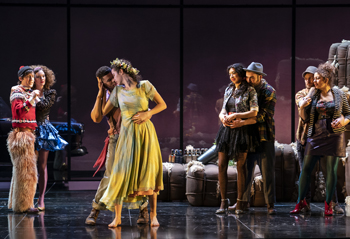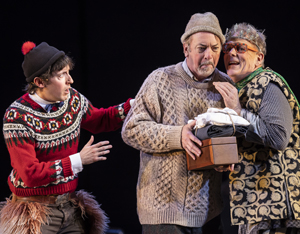
Shakespeare might not have been the first author to prescribe pastoral retreats as therapy for jaded mortals in need of moral realignment, but western literature in the centuries following has been virtually unanimous in its endorsement of vacations as the universal remedy.
The expansion of England's empire through offshore exploration during the Elizabethan age whetted its citizens' appetites for lavish depictions of exotic realms populated with curious creatures. Playgoers once content with domestic woodland deities like Oberon and Puck now demanded grotesque sub-human Calibans. To ensure the requisite commercial appeal for The Winter's Tale, Shakespeare dubbed its fantasy realm "Bohemia"—a hinterland then sufficiently remote as to render urban playgoers unperturbed by its cultural resemblance to the Scottish highlands abutting their own borders. This decision may have reflected marketing savvy at the time—Londoners eager to view the Sicilian court as a hotbed of decadence and the Bohemians as wholesome rustics had no trouble accepting the atrocities perpetrated by the former corrected by the compassion of the latter—but where does that leave costume designers in the 20th and 21st centuries, faced with the dilemma of representing global lifestyles to increasingly cosmopolitan audiences?
Formal wear having changed relatively little since Victoria's reign, the courtiers can be easily attired in black tie, but imaginations permitted free rein in dressing the natives of an agrarian utopia have found their expression in everything from ethnically-authentic dirndls and embroidered vests to Renaissance-Faire wools and woads, to American jazz-age raccoon coats.
For the recent Idle Muse production, Joshua Allard looked to historically accurate methods of clothing manufacture in societies where textiles were carefully recycled for maximum utility. This translated to weaving clean rags into wearable garments on a home-made loom, thus achieving a surface texture reminiscent of crafts-class potholders. "The clothing industry is the second largest polluting industry on the planet," he declares, "If fabric scraps and remnants can be re-stitched or re-shaped, it's more cost-effective than leaving them to rot in a stockroom or landfill."
Ana Kuzmanic's budget for the currently-running Goodman Theater Winter's Tale was more generous than those found on the storefront circuit, but in no way diminished the conceptual complexities associated with a story taking an abrupt turn midway from tragedy to comedy as explicated by Robert Falls, a director renowned for his auteur approach to classic repertoire—e.g. young prince Mamillius clad for bedtime in a faux bearskin lounger, nursery garb foreshadowing Antigonus' heroic sacrifice in the famous "exit pursued by a bear" scene. With so nebulous a narrative, where does a designer begin?
"Once upon a time, there was a King." Kuzmanic proclaims firmly. "That was our starting point."
The royal villa at the Goodman is furnished in stark Manhattan-penthouse chrome and glass, a decor Kuzmanic describes as "deliberately ambiguous—but familiar at the same time. The spectator's imagination is entrusted with the task of filling in the details, the way you would, when reading or listening to a fairy tale."
 How about the sudden leap from the delusions of a twisted monarch in the first act to a sunshiny spring sheep-shearing festival, complete with ceremonial Ovine crown, in the second? "We wanted to preserve the melancholy, while still honoring the switch in mood. Our inspiration was Eastern European circuses, because their comedy is highlighted by its juxtaposition with tragedy."
How about the sudden leap from the delusions of a twisted monarch in the first act to a sunshiny spring sheep-shearing festival, complete with ceremonial Ovine crown, in the second? "We wanted to preserve the melancholy, while still honoring the switch in mood. Our inspiration was Eastern European circuses, because their comedy is highlighted by its juxtaposition with tragedy."
Keeping up with the "rollercoaster" of the plot and supporting it visually without missing a beat is the biggest challenge, admits Kuzmanic. "Some of the design elements have to unfold gradually to reveal hidden character traits." She gives as an example Autolycus, whom we first meet as a gitfiddle-strumming troubadour, but later is revealed to be a petty thief, before finally emerging swathed in glam-rock splendor.
"We hope the contemporary references will make the story accessible, but also that our visual choices will provide the magic worthy of the fable we set out to tell."
The Winter's Tale runs at Goodman Theatre through June 9.
Mary Shen Barnidge
Contributing Writer

 Follow Us On Twitter
Follow Us On Twitter